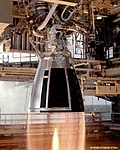RD-0216
| Country of origin | USSR |
|---|---|
| First flight | 1965-04-19[1] |
| Designer | OKB-154[1] |
| Manufacturer | PO Motorostroitel or Perm[2] |
| Application | ICBM propulsion |
| Associated LV | UR-100[1] |
| Successor | RD-0235 |
| Status | Retired |
| Liquid-fuel engine | |
| Propellant | N2O4[3] / UDMH[3] |
| Cycle | Oxidizer Rich Staged combustion[1] |
| Configuration | |
| Chamber | 1[3] |
| Performance | |
| Thrust | 219 kilonewtons (49,000 lbf)[3] |
| Chamber pressure | 17.4 megapascals (2,520 psi)[3] |
| Specific impulse | 313 s (3.07 km/s)[3] |
| Used in | |
| UR-100 Core Stage [4] | |
| Country of origin | USSR |
|---|---|
| First flight | 1973-04-09[5] |
| Designer | OKB-154[5] |
| Manufacturer | Krasny Oktyabr factory[2] |
| Application | ICBM propulsion |
| Associated LV | UR-100N, Rokot and Strela[5] |
| Status | Out of Production |
| Liquid-fuel engine | |
| Propellant | N2O4[6] / UDMH[6] |
| Cycle | Oxidizer Rich Staged combustion[5] |
| Configuration | |
| Chamber | 1[6] |
| Performance | |
| Thrust | 240 kilonewtons (54,000 lbf)[6] |
| Chamber pressure | 17.5 megapascals (2,540 psi)[6] |
| Specific impulse | 320 s (3.1 km/s)[6] |
| Used in | |
| UR-100N Second Stage [6] | |
The RD-0216 (Russian: Ракетный Двигатель-0216, romanized: Raketnyy Dvigatel-0216, lit. 'Rocket Engine 0216') and RD-0217 are liquid rocket engines, burning N2O4 and UDMH in the oxidizer rich staged combustion cycle.[1][3] The only difference between the RD-0216 and the RD-0217 is that the latter doesn't have a heat exchanger to heat the pressuring gasses for the tanks.[3] Three RD-0216 and one RD-0217 were used on the first stage of the UR-100 ICBM.[7] The engines were manufactured until 1974 and stayed in operational use until 1991. More than 1100 engines were produced.[3]
For the UR-100N project, while first stage propulsion was based on the more powerful RD-0233 engine. The second stage used a variation of the RD-0217 called the RD-0235 (GRAU Index 15D113).[8] It used a vacuum optimized nozzle extension, and thus had an extra 10 seconds of isp and 21 kilonewtons (4,700 lbf)[6] of more thrust. It has a fixed nozzle and relies on the RD-0236 vernier engine for thrust vectoring. While the engine has been out of production for a while, the UR-100NU and the Rokot and Strela use it as of 2015.[6]
See also
[edit]References
[edit]- ^ a b c d e "RD-0216, RD-0217. Intercontinental ballistic missile RS-10". KBKhA. Retrieved 2015-06-19.
- ^ a b Lardier, Christian. "Liquid Propellant Engines in the Soviet Union". Thirty-third IAA History Symposium. 19. American Astronautical Society: 39–73.
- ^ a b c d e f g h i "RD-0216". Encyclopedia Astronautica. Archived from the original on 2016-03-03. Retrieved 2015-06-19.
- ^ "RD-0217". Encyclopedia Astronautica. Archived from the original on 2016-03-03. Retrieved 2015-06-19.
- ^ a b c d "RD-0216, RD-0217. Intercontinental ballistic missile RS-10". KBKhA. Retrieved 2015-06-19.
- ^ a b c d e f g h i "RD-0235". Encyclopedia Astronautica. Archived from the original on 2015-08-24. Retrieved 2015-06-19.
- ^ Zak, Anatoly. "UR-100 Family". RussianSpaceWeb.com. Retrieved 2015-06-19.
- ^ "Rockot Launch Vehicle". Khrunichev State Research and Production Space Center. Retrieved 2015-06-19.
External links
[edit]

